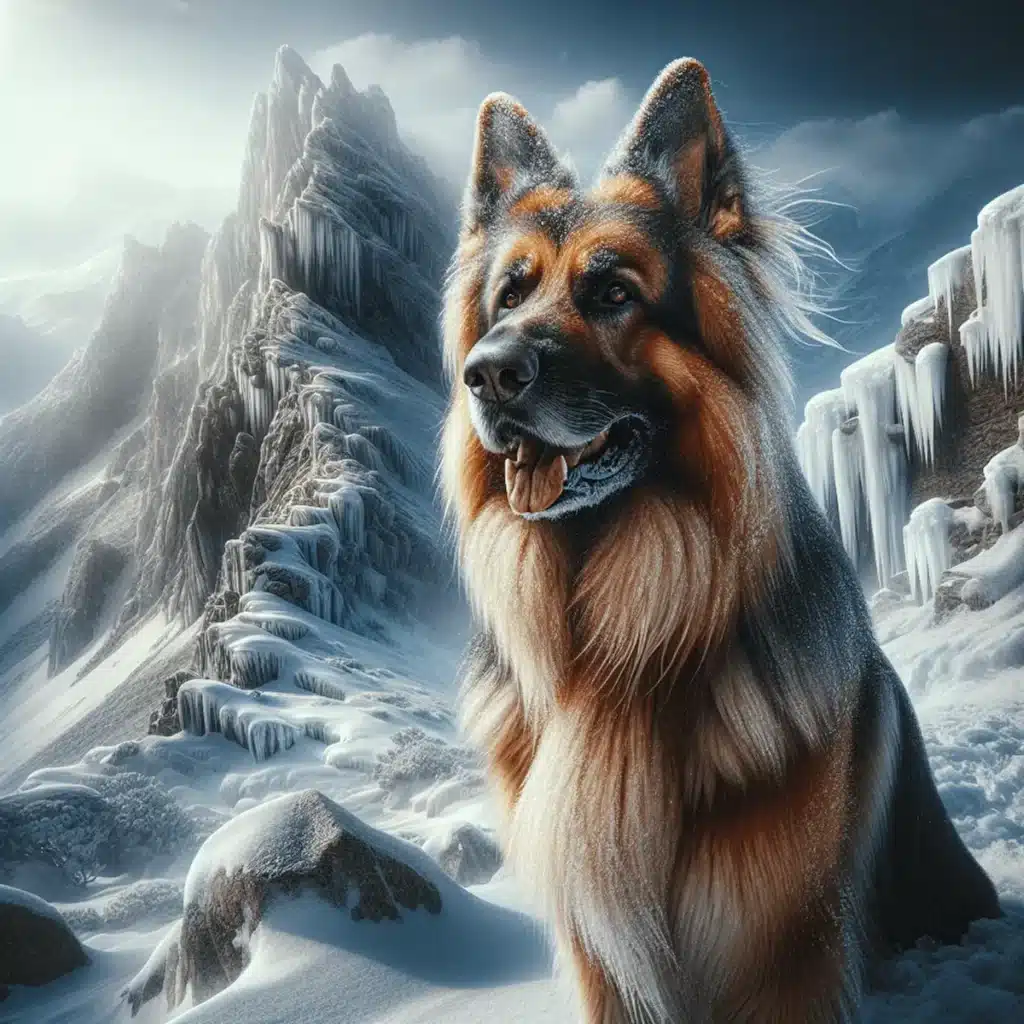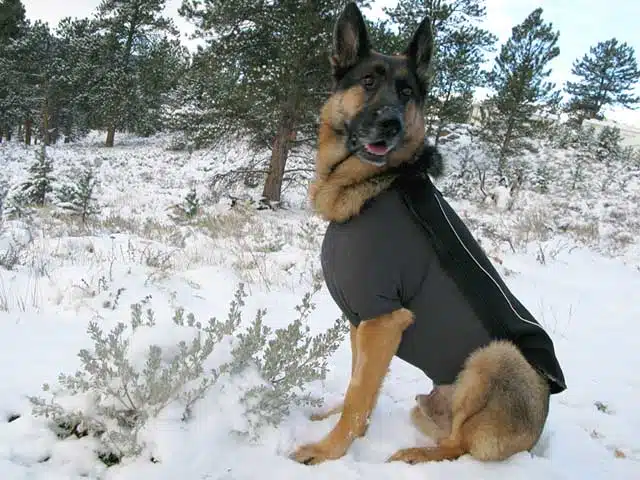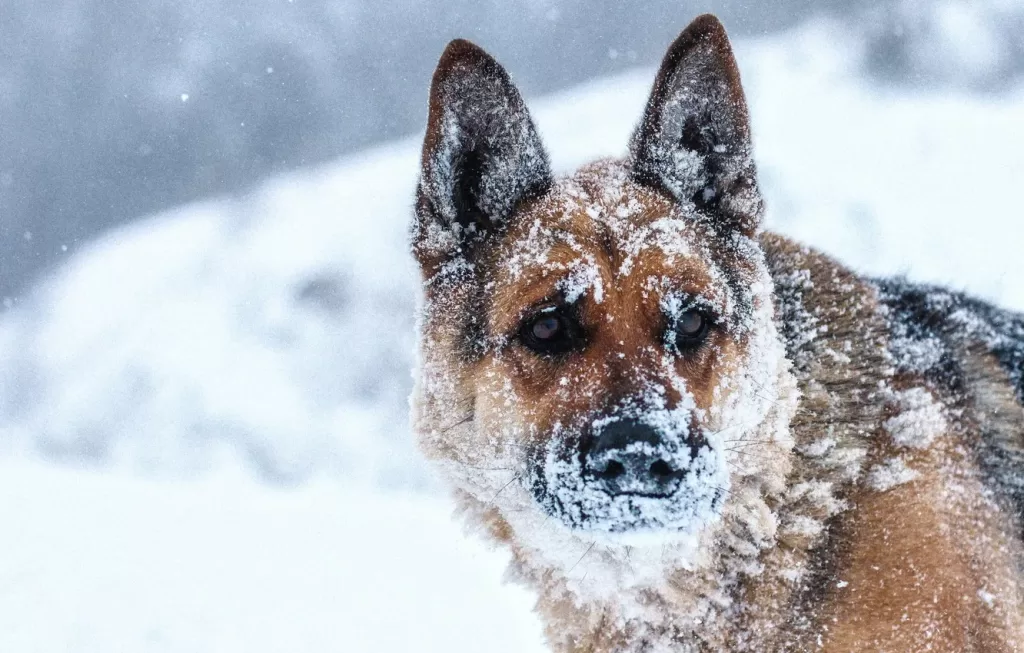German Shepherds are known for their versatility and adaptability to different environments with respect German Shepherd Cold Tolerance. However, when it comes to cold weather, it’s important to understand their specific cold tolerance. Here’s what you need to know
German Shepherds may vary in cold tolerance, but generally, temperatures around 40°F (approximately 4.44°C) can be uncomfortable for them. It’s best not to leave them exposed to such conditions for extended periods. Always ensure they have a warm place to retreat to and monitor them for any signs of discomfort.
Table of Contents
German Shepherd Cold Tolerance
German Shepherds have a moderate tolerance for cold temperatures due to their double-coated fur. Their thick undercoat provides insulation and helps regulate body temperature, while the outer coat acts as a water-resistant barrier. This natural protection enables them to withstand colder temperatures better than some other breeds.
Why Knowing Your German Shepherd’s Cold Tolerance Level Matters
While German Shepherds have a certain level of inherent cold tolerance, it’s crucial to recognize that individual dogs may vary in their ability to handle extreme cold. Factors such as age, health condition, and overall fitness can affect a dog’s tolerance for cold weather. Therefore, understanding your German Shepherd’s specific needs and limitations is essential for ensuring their well-being during colder months.
By being aware of these factors and taking appropriate measures, you can help keep your German Shepherd comfortable and safe in chilly conditions.
How Cold Weather Affects German Shepherds and Their Outdoor Activities

When it comes to German Shepherd Cold Tolerance, German Shepherds are affected in various ways, influencing both their physical health and energy levels, as well as their behavior and mood during outdoor activities.
The Impact of Cold Weather on German Shepherds’ Physical Health and Energy Levels
The cold can have a significant impact on a German Shepherd’s physical well-being and energy levels. Exposure to low temperatures can lead to decreased energy and increased fatigue, affecting their overall activity level. Additionally, extreme cold can cause health issues such as frostbite or hypothermia if proper precautions are not taken.
Effect of Coldness on German Shepherds’ Behavior and Mood during Outdoor Activities
Cold weather can also influence a German Shepherd’s behavior and mood during outdoor activities. They may exhibit signs of discomfort or reluctance to engage in their usual activities due to the discomfort caused by the cold. Moreover, their mood and enthusiasm for play or exercise may be dampened by the chilly conditions.
Also Read: How to Train Your German Shepherd to be a Guard Dog
Understanding these effects is crucial for ensuring the well-being of your German Shepherd in cold weather. By recognizing these impacts, you can take appropriate measures to protect your pet from the adverse effects of low temperatures.
Signs and Symptoms of Cold Stress in German Shepherds
German Shepherds, like any other breed, can experience discomfort and stress when exposed to extremely cold temperatures. It’s important for dog owners to be aware of the signs that indicate their German Shepherd may be feeling uncomfortably cold. By recognizing these signs, you can take appropriate measures to ensure your furry friend stays warm and safe. Here are some common indications that your German Shepherd is feeling the effects of the cold:
- Shivering: One of the most obvious signs that your German Shepherd is cold is shivering. Shivering is a natural response to help generate heat and maintain body temperature. If you notice your dog trembling or shaking uncontrollably, it’s a clear sign that they need to be warmed up immediately.
- Seeking Warmth: When dogs feel cold, they will naturally seek out warmer spots in their environment. If you notice your German Shepherd constantly trying to snuggle up against heaters, blankets, or other warm objects, it’s a sign that they’re feeling chilly.
- Decreased Activity: Cold weather can significantly impact a dog’s energy levels. If you observe your German Shepherd becoming lethargic or less active than usual during outdoor activities, it may be a sign that they are feeling the effects of the cold weather.
- Pale or Blue Gum Color: Another sign of cold stress in German Shepherds is changes in their gum color. When dogs are cold, their blood vessels constrict, leading to reduced blood flow and oxygenation. This can result in pale or even bluish gums.
- Whining or Restlessness: German Shepherds may vocalize their discomfort by whining or exhibiting restlessness when they’re feeling too cold. Pay attention to any unusual vocalizations or behaviors during outdoor excursions.
It’s important to note that these signs can vary from dog to dog, and some German Shepherds may display different indicators of cold stress. Understanding your individual dog’s behavior and body language will help you identify when they are feeling uncomfortably cold.
The Right Way to Protect Your German Shepherd from Cold Weather Conditions

As a responsible pet owner, it’s essential to take proactive measures to protect your German Shepherd from the harsh effects of cold weather. Here are some essential tips to keep your furry friend warm and safe in winter:
- Invest in Proper Outerwear: Consider getting a high-quality dog coat or sweater to provide an extra layer of insulation for your German Shepherd during outdoor activities.
- Limit Outdoor Exposure: Be mindful of your German Shepherd’s time outdoors in cold weather. Limiting exposure can help prevent discomfort and potential health issues.
- Create a Cozy Indoor Space: Ensure that your home provides a warm and comfortable environment for your German Shepherd. Provide soft bedding and consider using blankets to create a cozy space for them to rest.
- Adjust Diet and Hydration: In colder temperatures, your German Shepherd may require more calories to maintain body heat. Consult with your veterinarian to determine if any dietary adjustments are necessary. Additionally, ensure they have access to fresh, unfrozen water at all times.
- Protect Paws: Cold surfaces can be harsh on your dog’s paws. Consider using paw wax or booties to protect their paws from ice, snow, and salt.
By implementing these protective measures, you can help safeguard your German Shepherd from the challenges posed by cold weather, ensuring their well-being and comfort throughout the winter season.
Taking Care of Your German Shepherd in Cold Weather
Caring for German Shepherds in cold weather requires special attention and considerations to ensure their well-being. Here are some important tips to help you maintain your German Shepherd’s health and happiness during winter:
Special Care for German Shepherd Puppies in the Cold
German Shepherd puppies have less developed immune systems and are more susceptible to the cold. It’s crucial to provide extra care and protection for them during winter. Here are a few things to keep in mind:
- Limit outdoor exposure: Puppies have a harder time regulating their body temperature, so avoid prolonged outdoor activities in extremely cold conditions.
- Provide appropriate clothing: Outfitting your puppy with a well-fitting dog coat or sweater can help keep them warm when venturing outside.
- Monitor for signs of discomfort: Watch for shivering, reluctance to move, or seeking warmth excessively, as these may indicate that your puppy is feeling too cold.
Ensuring a Healthy Diet for Your German Shepherd in Winter
Maintaining a nutritious diet is essential for your German Shepherd’s overall well-being, especially during the colder months. Here are some dietary considerations to keep in mind:
- Adjust calorie intake: Cold weather can increase your dog’s energy expenditure as they try to stay warm. Consult with your veterinarian to determine if any adjustments need to be made to their portion sizes or feeding schedule.
- Incorporate warming foods: Adding warm, cooked foods like lean meats or broths can help provide comfort and additional warmth during colder days. However, be cautious not to overfeed or introduce new foods without proper guidance from your vet.
- Stay hydrated: Dehydration can still occur in winter, so make sure your German Shepherd has access to fresh water at all times. Consider using heated water bowls or checking them frequently to prevent freezing.
By considering these special care considerations and maintaining a healthy diet, you can ensure that your German Shepherd thrives even in the coldest of weather.
Engaging Your German Shepherd in Winter Exercise and Outdoor Play
When it comes to keeping your German Shepherd active and engaged during the winter months, there are various safe and enjoyable activities you can consider:
Safe and Enjoyable Winter Exercises for German Shepherds
- Long walks: Take your German Shepherd for long, brisk walks to provide them with physical exercise and mental stimulation. Ensure they are adequately protected from the cold with a well-fitted coat or sweater.
- Hiking: If the weather permits, consider taking your dog on winter hikes. Remember to watch out for signs of cold stress and adjust the duration of the hike accordingly.
- Interactive toys: Engage your dog with interactive toys that encourage physical activity indoors. Toys such as puzzle feeders or treat-dispensing toys can keep them mentally engaged while getting some exercise.
Fun Indoor Activities to Keep Your German Shepherd Active on Cold Days
- Indoor fetch: Clear a space in your home to play fetch with your German Shepherd. This activity provides them with physical exercise without exposing them to harsh outdoor conditions.
- Obedience training: Use indoor time to reinforce obedience commands and teach new tricks. Mental stimulation is just as important as physical exercise for your dog’s overall well-being.
By incorporating a mix of outdoor and indoor activities, you can ensure that your German Shepherd stays active and healthy throughout the winter season.
Grooming Techniques to Support Your German Shepherd’s Coat Health in Cold Climates
As the temperature drops, it becomes essential to pay special attention to your German Shepherd’s coat health in order to keep them comfortable and protected in cold climates. Here are some key points to consider when grooming your German Shepherd for the winter:
Understanding the Double-Coated Fur of German Shepherds and Its Insulating Properties
German Shepherds have a double coat consisting of a dense undercoat and a longer outer coat. This unique fur structure provides insulation against both cold and heat, helping them regulate their body temperature in various weather conditions. The undercoat acts as a natural insulator, while the outer coat repels moisture, keeping the undercoat dry.
Essential Winter Grooming Practices for Your German Shepherd
- Regular Brushing: Brushing your German Shepherd’s coat regularly helps remove loose fur and prevents matting. This not only promotes healthy circulation but also allows air to circulate through the fur, aiding in temperature regulation.
- Bathing: Limit baths during the winter to prevent stripping the natural oils from their skin and coat. When bathing is necessary, use a moisturizing shampoo specifically formulated for dogs with double coats.
- Trimming: Avoid trimming your German Shepherd’s coat too short during winter, as the longer fur provides better insulation. However, keeping the fur around their paw pads trimmed can help prevent ice balls from forming between their toes.
By understanding and implementing these grooming practices, you can help maintain your German Shepherd’s coat health and ensure they remain comfortable and well-protected in cold climates.
Providing Adequate Shelter for Your German Shepherd in Chilly Conditions
When it comes to providing shelter for your German Shepherd in cold weather, there are important features to consider to ensure their comfort and safety:
- Insulation: Look for a shelter with proper insulation to retain your dog’s body heat and protect them from the cold.
- Waterproofing: The shelter should be waterproof to prevent rain or snow from seeping inside, keeping your German Shepherd dry and warm.
- Elevated Flooring: Choose a shelter with an elevated floor to keep your dog off the cold ground and away from any moisture.
- Proper Sizing: The shelter should be spacious enough for your German Shepherd to stand, turn around, and lie down comfortably.
- Wind Protection: Ensure the shelter has a windbreak or is positioned in a way that minimizes exposure to harsh winds.
- Warm Bedding: Provide warm, insulating bedding inside the shelter, such as blankets or straw, to enhance comfort and warmth.
By considering these features, you can create a suitable cold-weather shelter for your German Shepherd, allowing them to seek refuge from low temperatures and inclement weather.
Training Your German Shepherd to Adapt to the Cold
German Shepherds can adapt to cold weather with proper training and conditioning. By helping your German Shepherd build resilience to low temperatures, you can ensure their comfort and well-being in chilly conditions. Here are some tips for training your German Shepherd to adapt to the cold:
- Gradual Exposure: Introduce your German Shepherd to cold weather gradually, allowing them time to adjust to lower temperatures.
- Outdoor Activities: Engage your dog in regular outdoor activities during milder cold days, gradually increasing exposure to cooler temperatures.
- Physical Conditioning: Keep your German Shepherd physically fit through regular exercise, which helps improve their overall tolerance to cold weather.
- Positive Reinforcement: Use positive reinforcement techniques such as treats and praise to create a positive association with being outdoors in colder weather.
- Appropriate Gear: Outfit your German Shepherd with suitable winter gear like a warm coat or boots when venturing out in very cold conditions.
By employing these training methods, you can help your German Shepherd acclimate to the cold and build the resilience needed to enjoy outdoor activities even in chilly weather.
The Role of Breed Temperament in German Shepherds’ Response to Cold Weather
German Shepherds, like all dog breeds, have their own unique temperaments that influence how they respond to different situations, including cold weather. Understanding your German Shepherd’s temperament can help you better anticipate their preferences and needs when it comes to facing the cold. Here are some key points to consider:
- Energy Levels: German Shepherds are known for their high energy levels and active nature. This means that some German Shepherds may actually enjoy the cold weather as it provides them with a refreshing environment for exercise and play. On the other hand, dogs with lower energy levels may find the cold more challenging and prefer to stay indoors.
- Coat Density: The double-coated fur of German Shepherds plays a crucial role in insulating them from both heat and cold. Dogs with thicker and denser coats are generally better equipped to handle colder temperatures, while those with shorter or sparser coats may feel the cold more intensely.
- Personal Preference: Just like humans, dogs have their own personal preferences. Some German Shepherds simply enjoy the sensation of being in cooler temperatures, while others may find it uncomfortable or distressing. Pay attention to your dog’s behavior and body language when exposed to cold weather to gauge their individual response.
- Training and Socialization: Proper training and socialization from an early age can help your German Shepherd develop resilience and adaptability to various weather conditions, including the cold. Exposing them gradually to colder temperatures during puppyhood can help them build tolerance and confidence in facing low temperatures.
- Health Conditions: Certain health conditions, such as arthritis or joint problems, can make it more difficult for German Shepherds to tolerate extreme cold. If your dog has any pre-existing medical conditions, consult with your veterinarian for specific recommendations on how to best support their well-being in cold weather.
Understanding your German Shepherd’s temperament and individual preferences can guide you in providing the most appropriate care and protection during cold weather. Whether they enjoy romping in the snow or prefer cozying up indoors, tailoring their environment and activities to their needs will ensure their comfort and happiness throughout the winter season.
Conclusion
As a responsible German Shepherd owner, it’s crucial to understand and cater to your dog’s cold tolerance. By recognizing the signs of cold stress, providing adequate shelter, and engaging in proper grooming and care, you can ensure your German Shepherd’s well-being in chilly conditions. Remember to consider their individual temperament traits and adjust your approach accordingly. With the right knowledge and proactive measures, you can help your German Shepherd thrive even in colder climates.

